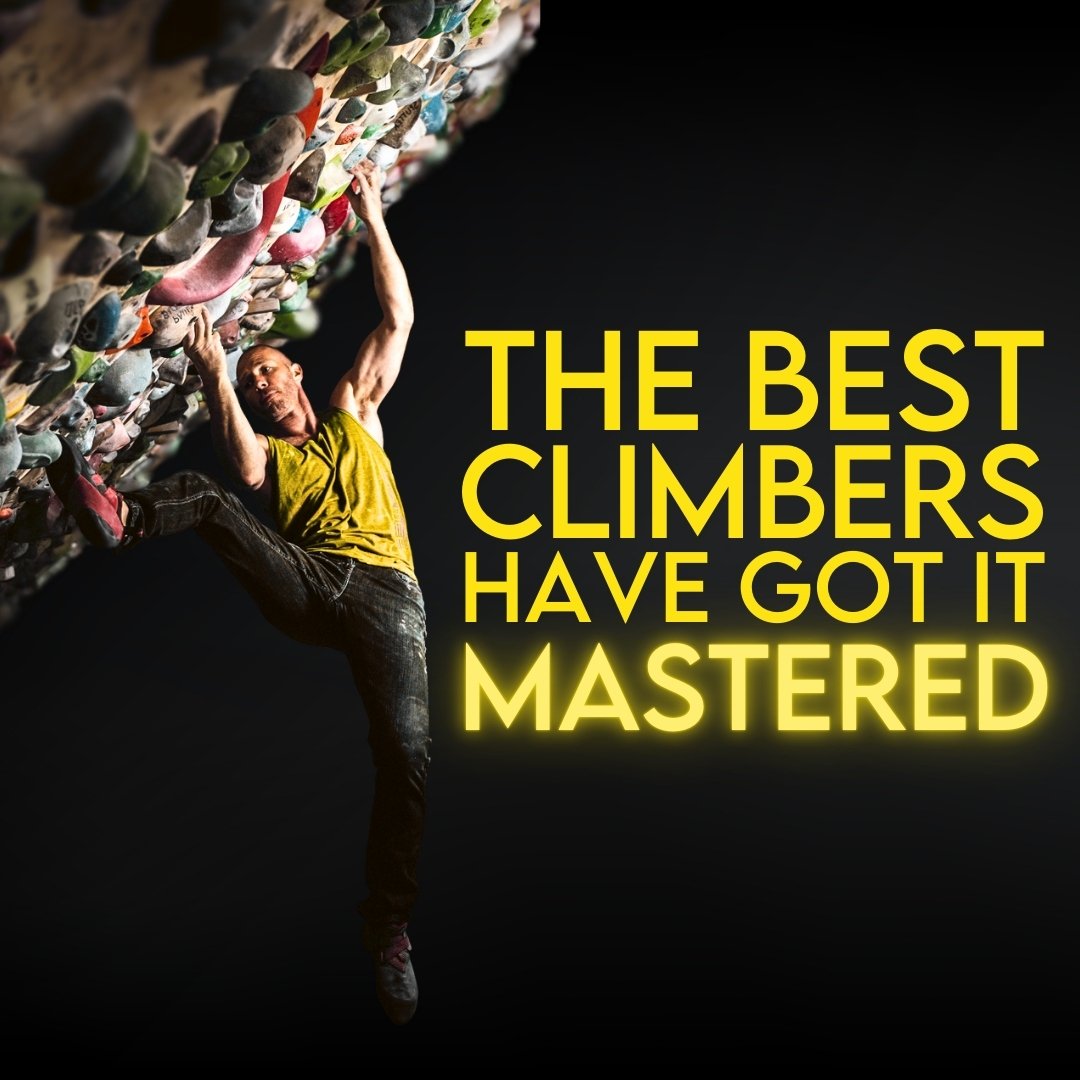Taped Tips | Climb Taller AND Smaller
Short climbers are good at getting scrunchy, and tall climbers are good at climbing extended, right?
Ummm, no. Not always.
Actually, not even most of the time.
Believing that, particularly if you’re one of those short or tall climbers, is a trap. I’m going to tell you why, and I’m going to tell you exactly how to make sure you don’t fall into this trap. Or if you’re in it already, how to get out, so that we can all extend our useful range.
Ok, over the course of hundreds of in-person sessions over the past decade, I’ve met many short climbers who think they are good at getting high feet. Most tall climbers think they are good at using low feet. And some actually are, but the fact is, most just aren’t. Sure, they might choose slightly higher or further feet than the average sized climber chooses, but relative to their size, they usually have a pretty similar range.
Why does that even matter?
It matters because shorter and taller climbers are told – or tell themselves – this story that they’re already good at it, and so they rarely, if ever, explore further. And because of this, they are held back from actually improving their range.
It’s likely that if you climb in an area that rewards high-steps and big lock-off’s – like the Blue Mountains or the New River Gorge – that you’ve adapted to being good at getting bunched up, particularly if you’re average height or taller. But if you’re short and you climb in those areas, it’s possible that you’ve actually gotten better at getting stretched out, but the bunchy nature of the climbing is, in reality, just a comfortable range for you. And even you, the short climber who uses high feet, are leaving options for even higher feet on the table.
And the same goes for taller climbers. You skip cruxes and excel in areas that reward climbing tall, so the story you tell yourself or have been told, is that you’re good at getting stretched out.
But are you, really?
We aren’t falling for that.
Because the best climbers? They can get bunchy, they can get extended, and they know when to employ which skill.
We are going to learn how to do that, too.
Let’s define what we’re talking about. If we look at the full span of the average climber, their useful range is a little smaller than that. And the range they regularly choose? Even smaller still.
On average, a climber’s useful range extends to probably around the wrists and ankles, and their often chosen range, to around mid-forearm and mid-shin.
That might seem harsh, but in all but two or three cases over my nearly 30 years of climbing, when someone says they are “fully extended” they often have another 6-8 inches before that’s true. Consider checking yourself next time you say you’re fully extended.
This useful range is what many climbers refer to as the “box” that we can climb in.
I’ve used this term for a long time myself, but it’s misleading as we don't actually have access to everything inside the box that’s created by our widest useful range. There's a limit to not only how extended we can get, but also how bunchy we can get.
For the average climber, their useful range on the inside of the box seems to be a little inside their shoulder width and somewhere around mid-thigh. Any holds inside of that often don’t even register as options. But when we look at the common chosen range, many of us tend to choose holds not much higher than our knees and only just outside of our shoulders.
So I now prefer to look at this useful range not as a box at all, but as a frame. And while the best climbers have very wide frames that they move in, most of us have frames that are way too thin. Which means that we’re leaving A LOT of options on the table. And in my opinion, it’s important to first understand the inner and outer limits of your box so that you can better utilize the range you currently have.
Ok, so the outside of the frame is how extended you can be and still have some semblance of control. And knowing those limits does several things. It allows you to anticipate how much you have to give to a big move. It allows you to know what you need to do with your feet to make that position advantageous. Spending time in and improving at these extended positions will not only reduce hesitation when faced with a big move and allow you to create tension or generate momentum from those positions, but it will open up new ways to get through every section of every climb you do.
On the flip side, the inside of the frame is how bunchy you can be and still be effective. Can you actually load your feet when they are at the same level as your hands? Or how high is too high? Does it feel more chaotic or stressful when you get scrunched? Getting better at these bunched up positions is going to give you more options in more situations.
And the interesting thing is that very often, the two work together. It’s incredibly common that when you do a big move that leaves you extended, you’re then faced with, a move or two later, having to get your feet really high.
Like I talked about in the last Taped Tips episode, hard climbing is very often about moving from a not quite stable position, through a very unstable path, to another not quite stable position. It’s common that those moves are big, followed by having to get your feet close to your hands, sometimes just to do another big move from that scrunchy position.
So learning just one expanded range is not enough – we need to be able to use both.
So the question is:
How can we avoid falling for the trap of these stories and widen our frames, or improve our useful range?
The best way I’ve seen, by far, to accomplish both things is to use a drill that, in my opinion, might be the most underrated skill drill in all of climbing. We call it One Size Fits All.
First let’s look at how to do the drill, and then we’ll examine how it helps us reach our goals.
What you’re going to do is follow the set hand sequence for a problem but use any feet. First you’ll climb the problem trying to be as extended as you possibly can for each move. That means that for each move you’ll have to make a decision. Look up at your hand hold and then figure out where the MOST distant foot you can use is. It can be directly below or out to the side or anywhere – as long as it challenges you to get extended. And feel free to walk your feet around on several holds to get into position to try the move.
Now here’s the real magic: Evaluate your choices. Did you do the move easily, or did you fall off? Did you fall off because you lost tension, or chose a poor position, or is the hold actually just too far away to keep your foot on? Now re-do the problem, or the individual moves, making better – or at least different – choices.
Now repeat the problem, but doing every move as scrunchy as possible. You can match hand-foot, or you can even step your foot above your hands. What we’re looking for here are positions you’re a little uncomfortable in, but that you can still make work for the sequence you’re doing. The goal isn’t just to get your feet as high up the wall as possible – it’s to find challenging positions that feel a little too bunchy for you, and then find a way to make them work.
Start out doing One Size Fits All on relatively easy terrain. It’s going to be physically challenging, even on the biggest holds. As you get used to it, move to harder warmups, then to moderates, and beyond. And you’ll find that your useful range changes as the hand and foot holds get worse. So once you’re doing it well on good holds, move it to worse holds. That’s going to help it translate to hard climbing outside.
One Size Fits All works best on a spray wall or densely-set bouldering wall. You’ll certainly still get benefit from it on commercial boards, but keep in mind that if you’re on a board that’s on a strict grid, there are going to be big gaps between the options you can and can’t use, so you might not be able to maximize your useful range.
And remember, you get to decide where to put your feet, essentially choosing the body positions. If you’re switching up the angles and grip types enough, it’s likely that you’ll be constrained in a realistic enough way that you won’t always get your top choice of body position, but you’ll also have to use some intention not to just default to where you’re strongest.
You’ll want to get plenty of rest between efforts and don’t feel like you have to do entire problems. You can pick individual moves or sequences that you have a hard time with and spend time on those. But keep the goal of the session in mind. LIke I said, it’s physically challenging, so if you get too sucked in you might be derailed.
This drill, and getting better at climbing both extended and bunched, not only prepares you for the cruxes of boulders and routes that will demand this of you, but it also gives you more options on nearly every single move you ever do. More options often means that you’ll more quickly find the one that suits you and you won’t get shut down on as many moves at your top level.
By gradually learning what is actually possible for you – in both directions – you’re better prepared to not believe those stories that you’re just naturally good at this skill.
Now you know you’re good at it because you’ve worked for it.
EXPLORE FURTHER
You might enjoy these related articles, episodes, and other resources:
Taped Tips | The Secret to Hard Moves that Most Climbers Are Missing
Taped Tips | The Setup Mistake Climbers Make on Hard Moves
Our Movement Practice Resource Page
Marina Inoue | Does Size Matter?
SUPPORT + CONNECT
Help us keep the show sponsor-free when you join our Patreon Community for as little as $3.
Get two or more bonus episodes every month on Patreon, Spotify, or Apple.
Subscribe to THE CURRENT and get a monthly exploration of how we can all become better climbers.
Find Power Company on Instagram and YouTube.
Share this episode with a friend who needs to hear it.
LISTEN ON YOUR PODCAST APP OF CHOICE
We’re a proud founding member of the Plug Tone Audio Collective, a group of the best, most impactful podcasts in the outdoor industry.


























A better way to view grades and progression?